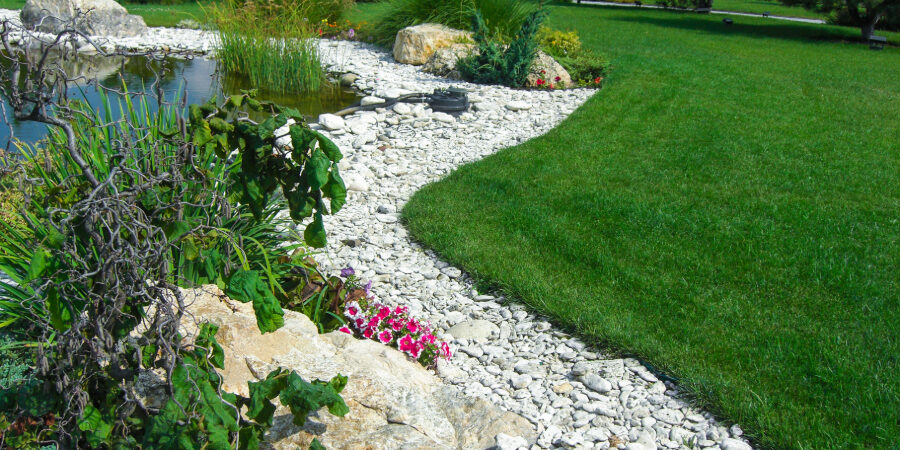A beautiful yard is every homeowner’s goal. But weeds and mud can make it hard to maintain. Other yard borders, like plastic or wood, just don’t hold up. They might look good at first, but after a season or two, they start to warp, crack, or break apart. Suddenly, weeds are popping up where they shouldn’t, and the clean edges you worked so hard to create are gone. It can feel like all your effort was for nothing, and you’re back to square one, trying to fix the same problems all over again.
Fortunately, there’s a solution designed to handle these challenges with ease: BaseEdge HD Steel Edging. It’s tough, long-lasting, and easy to use. This edging keeps your yard neat and tidy, no matter the weather. In this blog, we’ll show you how it works and why it’s a smart choice for your yard.
Why Choose Steel Landscape Edging?
BaseEdge HD offers a superior alternative to plastic or wood, combining strength, practicality, and style.
Durability That Lasts
Steel doesn’t warp, crack, or rot. It stands up to rain, heat, and heavy use. BaseEdge HD Steel Edging stays strong even after years of use. It won’t break under pressure from lawn equipment, foot traffic, or shifting soil.
Low Maintenance
This edging makes yard care easier. Once installed, it stays in place. You won’t need to fix or replace it often. It holds its shape and keeps your yard looking sharp, season after season.
Eco-Friendly Design
Steel edging is the sustainable and smart choice. Steel is recyclable, making it an environmentally friendly option compared to disposable materials like plastic. Additionally, BaseEdge HD Steel Edging reduces the need for chemical weed treatments by creating a physical barrier that stops weeds before they spread. It’s better for your yard and the environment.
Tackling Two Major Yard Problems
Weed Control
Weeds are a common problem for homeowners. They grow quickly and ruin the look of your yard. BaseEdge HD Steel Edging acts as a wall to stop weeds from spreading. It keeps mulch and soil in place, leaving no gaps for weeds to grow. You’ll be able to control weeds easier while using fewer chemicals, which is better for the environment.
Mud Management
Mud can make your yard messy and hard to use. Without clear borders, it spreads into walkways and garden beds. BaseEdge HD keeps mud in check. It improves drainage, prevents water pooling, and stops soil from washing away. Your yard stays clean, even after heavy rain.
Features That Make BaseEdge HD Stand Out
Heavy-Duty Steel Construction
Unlike wood or plastic, which degrade under pressure, BaseEdge HD is engineered to last. Its heavy-duty steel design resists cracking, warping, and weather-related damage, even in extreme conditions. Whether it’s enduring lawn equipment, foot traffic, or shifting soil, BaseEdge HD stays strong and reliable.
Sleek, Professional Design
Steel edging gives your yard a polished look. Its clean lines and sharp edges make garden beds, pathways, and driveways look neat. Whether you want a modern or classic style, BaseEdge HD fits perfectly.
Versatility
Every yard has a different layout, and BaseEdge HD Steel Edging is designed to adapt to any outdoor space. Whether you’re working with straight lines, curves, or custom layouts, this edging delivers the flexibility to bring your vision to life.
How to Use BaseEdge HD Steel Edging
Step 1: Plan Your Yard
- Look for areas where weeds or mud are a problem, like garden beds or walkways.
- Sketch a simple layout of where you want the edging to go.
Step 2: Prepare the Ground
- Clear away weeds, grass, and any debris.
- Level the soil so the edging will sit flat.
- For muddy spots, lay down fabric to improve drainage.
Step 3: Install the Edging
- Place the edging along your planned borders.
- Use the included stakes to secure it tightly in place.
Step 4: Add the Finishing Touches
- Fill the area around the edging with mulch, soil, or gravel.
- Add plants or stones to complete the look.
That’s it! With these simple steps, your yard will look clean, tidy, and professional.
Why BaseEdge HD Is a Cost-Effective Investment
Long-Term Durability
Steel edging lasts much longer than plastic or wood. You won’t need to replace it often, saving you time and money.
Eco-Friendly Benefits
By reducing the need for chemical weed control and offering recyclable materials, BaseEdge HD supports sustainable landscaping practices that benefit both your yard and the environment.
Professional Results With DIY Installation
This edging gives your yard a high-end look without the high cost. It’s easy to install, making it a great option for DIY projects.
Transform Your Yard with Backyard Bases
At Backyard Bases, we understand the frustrations homeowners face when it comes to yard maintenance. That’s why we’ve designed BaseEdge HD Steel Edging to tackle your toughest landscaping challenges with ease.
Whether you’re battling weeds, managing mud, or simply looking to upgrade your outdoor space, BaseEdge HD delivers a solution that lasts. Ready to take control of your yard? Visit our BaseEdge HD product page and start your transformation today.
Transform Your Yard With Ease
Weeds and mud don’t have to be a headache. With BaseEdge HD Steel Edging, you can keep your yard clean, neat, and easy to maintain. Its strength, simple design, and eco-friendly features make it a smart investment for any homeowner. Stop settling for temporary fixes. Invest in BaseEdge HD Steel Edging and experience the difference it makes in creating the yard you’ve always wanted.
